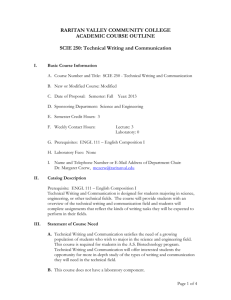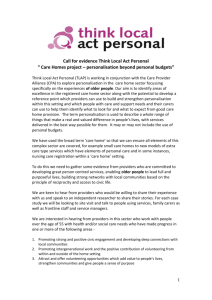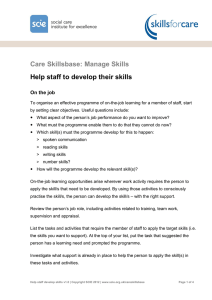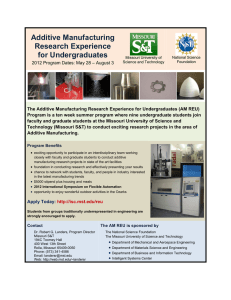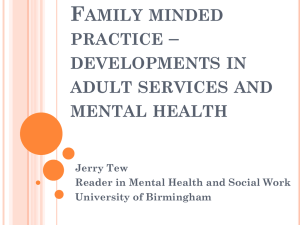Use quality management tools to solve problems
advertisement
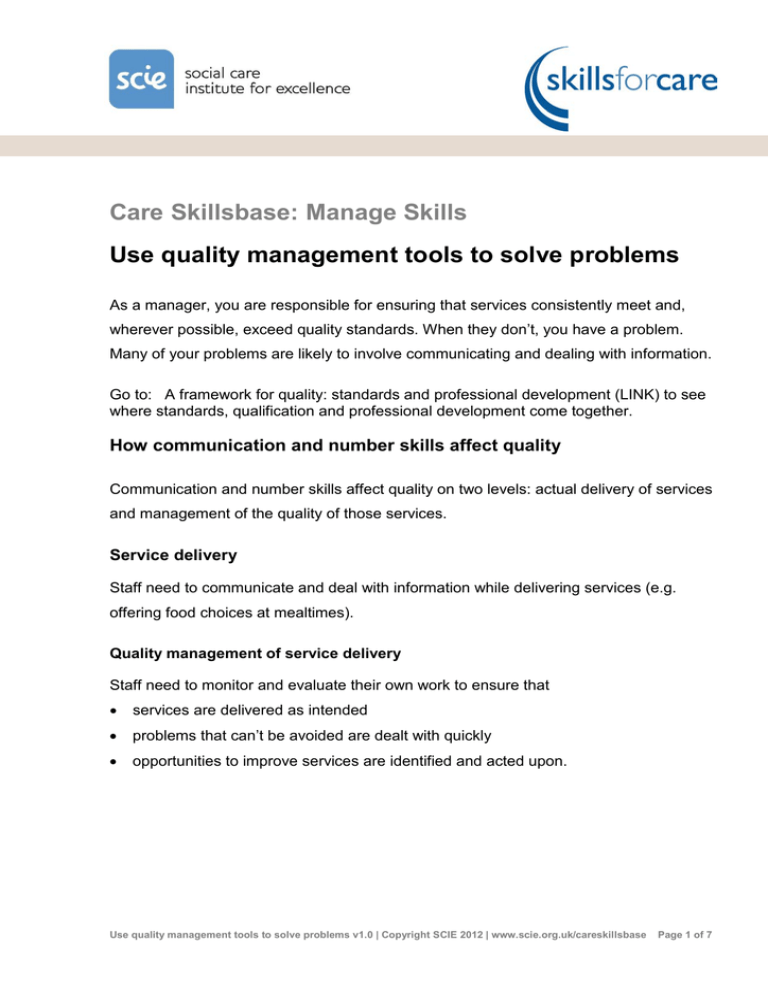
Care Skillsbase: Manage Skills Use quality management tools to solve problems As a manager, you are responsible for ensuring that services consistently meet and, wherever possible, exceed quality standards. When they don’t, you have a problem. Many of your problems are likely to involve communicating and dealing with information. Go to: A framework for quality: standards and professional development (LINK) to see where standards, qualification and professional development come together. How communication and number skills affect quality Communication and number skills affect quality on two levels: actual delivery of services and management of the quality of those services. Service delivery Staff need to communicate and deal with information while delivering services (e.g. offering food choices at mealtimes). Quality management of service delivery Staff need to monitor and evaluate their own work to ensure that • services are delivered as intended • problems that can’t be avoided are dealt with quickly • opportunities to improve services are identified and acted upon. Use quality management tools to solve problems v1.0 | Copyright SCIE 2012 | www.scie.org.uk/careskillsbase Page 1 of 7 For an organisation to do this, all staff should understand • how the organisation’s systems and processes are meant to work • what that implies for their own role. To do that, staff need the ability to deal with information and communicate. Communication and number skills give staff the ability. Problems related to dealing with information and communicating Service delivery problems are rarely straightforward. In addition to the actions of staff, factors may include materials and equipment, workplace systems, outside suppliers and more. Not surprisingly, it isn’t always easy to separate cause from effect. This is particularly true when it comes to problems dealing with information and communicating. Quality management experts recommend involving staff as fully as possible in any problem-solving. This increases staff understanding of (and commitment to) quality. It also gives you the widest possible perspective on any problem. Solving problems collaboratively with staff Problem-solving normally follows this simple process: • Define the problem. • Identify the possible causes. • Establish the most likely causes. • Plan action to address those causes. • Review the results. Define the problem In order to define the problem, it is important to make sure everyone agrees how things are meant to happen in the area where the problem has been identified. Use quality management tools to solve problems v1.0 | Copyright SCIE 2012 | www.scie.org.uk/careskillsbase Page 2 of 7 To do this, review procedures in that area to identify • each step involved in the activity (and how the step contributes to the overall objective) • what is meant to happen in that step • which staff are involved • any documentation that specifies the activity (e.g. instructions, task specifications, risk assessments, competency statements, quality standards; also, any relevant job descriptions and person specifications). Arrive at a clear and concise description of what should be happening. Present staff with this step-by-step breakdown of the activity to arrive at a shared understanding of what is meant to happen. Be aware that, because problems generally indicate that a process is not working the way it is meant to, it is easy for the people involved to become defensive. Avoid this by presenting the problem as an opportunity to make an improvement. Make it clear to staff that your focus is improvement, not apportioning blame for what has happened in the past. Identify the possible causes Collect the views of staff on possible causes for the problem. Quality management tools you may find useful include: • 5 Whys • Cause-and-effect diagram. The 5 Whys technique simply consists of asking the question ‘Why?’ five times to get to the root of the problem. For example: Problem: The laundry machine has broken. Why? – The filter is blocked. Why? – No one has checked it for six months. Use quality management tools to solve problems v1.0 | Copyright SCIE 2012 | www.scie.org.uk/careskillsbase Page 3 of 7 Why? – The member of staff who used to do it left and no one knows how. Why? – It’s not part of their job. Why? - No one is officially responsible for maintaining the machine. The cause-and-effect diagram (also known as a fishbone diagram and an Ishikawa diagram) is a good way to collect ideas and categorise them. On a flip chart, white board or piece of paper, draw this diagram: Write the problem in the ‘effect’ box on the right (the ‘head’ of the fish). Tell people to concentrate only on causes at this stage. Collect their ideas about causes on the ‘bones’ running off the ‘spine’. (Post-it notes may be helpful for staff to write on.) Categorise the ideas and give each category its own ‘bone’. On the next page there is an illustration of a partly completed diagram, using as an example the problem of people not eating the food they have ordered. Use quality management tools to solve problems v1.0 | Copyright SCIE 2012 | www.scie.org.uk/careskillsbase Page 4 of 7 Skills difficult to explain menus to people menu cards don’t give carers enough information Systems carers have a lot of other things to do no records kept of what people like or don’t like to eat people not eating food they have ordered Typical categories to collect problems under include: • skills – anything related to what people do • surroundings – anything related to where the problem occurs • suppliers – anything related to suppliers • systems – anything related to the organisation’s systems. Establish the most likely causes Refer to your step-by-step activity breakdown to agree with staff what the most likely causes of the problem are. The 5 Whys technique may be helpful here to get to analyse the possible causes of the problem you are trying to solve. See the next page for an example using a simple template. Use quality management tools to solve problems v1.0 | Copyright SCIE 2012 | www.scie.org.uk/careskillsbase Page 5 of 7 Activity where problem occurs Intended outcome of activity Staff involved in activity Relevant documentation What should happen Step(s) where problem occurs What should happen and why What does happen and why Feeding lunch People eat the lunch they have ordered Morning shift carers, duty nurse, kitchen staff Menus, task specifications, nutrition tables, weight charts, kitchen wastage records 1. Lunch menus agreed monthly, reviewed by dietician, menu cards prepared 2. Carers take menu cards to individuals daily, explain choices, take orders 3. Carers deliver menu orders to kitchen 4. Kitchen prepares orders 5. Carers take trolleys round, assist people in dining room and in own rooms 6. People eat lunch 7. Carers return trays to kitchen when person has finished Step 2. Explaining menu choices Carer should explain that they have brought lunch menu so that the person can choose food then make sure the person understands the menu and what the dishes contain. If people understand the menu, they are more likely to choose food they will eat. Carers show people menus but don’t explain. People choose food they don’t like, then leave most uneaten. Carers don’t have a lot of time to go through the menu; sometimes carers don’t understand the menu items, so can’t advise [etc. etc.]. Plan action to address those causes Involve all staff in planning how to address the causes you have identified. Make sure that staff believe any action agreed is practical. Use quality management tools to solve problems v1.0 | Copyright SCIE 2012 | www.scie.org.uk/careskillsbase Page 6 of 7 Review the results You may find a check (or tally) sheet useful to monitor how effective any action is. This tool is just a simple tracking form (see example below). The problem being tracked is noted on the left. Every time the problem occurs, a mark is made on the right. Period: June Area: West wing Tray returned with uneaten food How many Total breakfast order II 2 lunch order IIII 5 dinner order III 3 The example above is recording frequency. The tool works equally well if you want to track other aspects of a problem, such as where or when the problem occurs, or completion of steps in a procedure. The check sheet is easy for any member of staff to use. Use quality management tools to solve problems v1.0 | Copyright SCIE 2012 | www.scie.org.uk/careskillsbase Page 7 of 7
